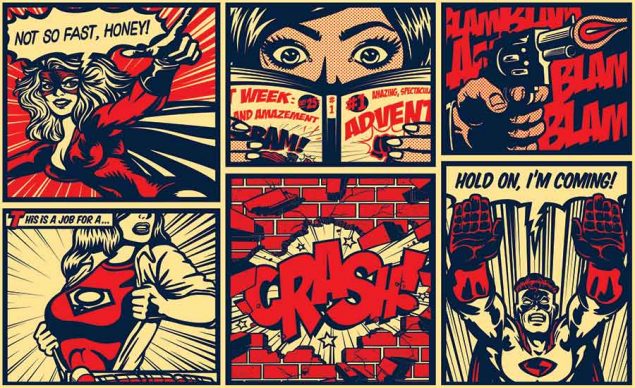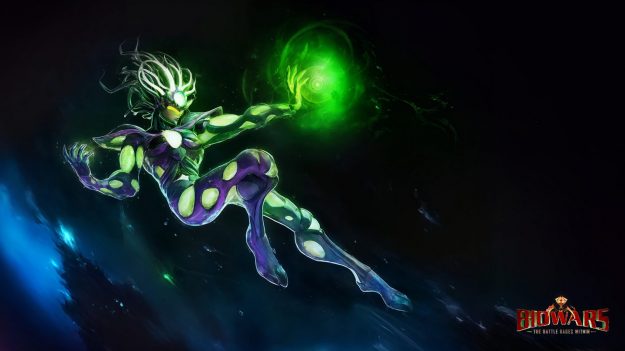Related Resources
Did you know that the very first comic book was created in 1837? It is called The Adventures of Obadiah Oldbuck, and its creator is Rodolphe Töpffer — the first comic book artist in history.
The production of comic books took off from the early 20th century, and the popularity of the beloved medium isn’t showing signs of slowing down. In fact, comic book sales in the U.S. hit an all-time high in 2020, reaching $1.28 billion.
In this post, we will introduce you to the four major comic book ages — golden, silver, bronze and the modern eras of comics.
By learning more about the defining periods from the history of comics, you’ll gain a better understanding of some of your favorite superheroes and comic book stories!

Golden Age Of Comics
In 1938, National Publications released the first issue of the Action Comics series, marking the start of the Golden Age of Comics. This comic book introduced readers to Superman — one of the first major superheroes!
Superman appeared in the years when the whole world was facing a threat from Hitler’s antisemitic Nazi Germany. The Great Depression was also in full swing. The stories about Superman reflected the fears of everyday people, and he was portrayed as the superhero everyone needed — he protected the innocent, weak and oppressed.
During this period, comic books expanded beyond just superheroes to include genres such as crime, horror, and romance.
Companies like Timely Comics, which later became Marvel, and Fawcett Comics introduced new characters like Captain Marvel (now known as Shazam) and the Sub-Mariner, making comics more exciting and appealing to a broader audience.
During the Golden Age of Comic Books, some of the most iconic superheroes were created, including Batman, Robin, Wonder Woman, The Flash, The Green Lantern, Aquaman, The Human Torch and Captain America.
The cover for the first Captain America comic book defined the Golden Era of comics. It depicts the new brave superhero punching Hitler:
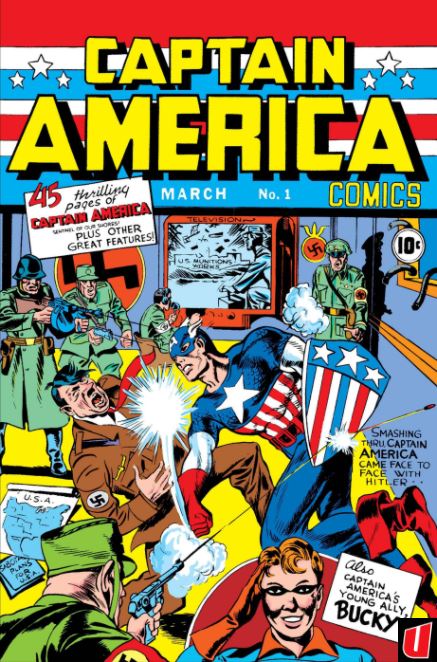
The Golden Age of Comics lasted from 1938 until 1956. During this time, comic books became increasingly popular among American youth, and that remains true to this day. After all, comic books, alongside jazz music, are one of the rare original products of the American culture.
As superhero comics became increasingly popular during the Golden Era, some psychiatrists, such as Dr. Fredric Wertham, warned parents of the dangers of violence and sexuality depicted on the pages. The attempts to censor comics, however, remained fruitless.
In the end, it wasn’t the warnings of Dr. Fredric Wertham that steered children away from reading comic books. The end of the war and the loss of the modern world’s greatest real-life villain made kids lose interest in superheroes. Who were superheroes supposed to fight against when Hitler was out of the picture?

Silver Age Of Comics
In the 1950s, the world was recovering from the consequences of WW II. At the same time, it was facing the hardships caused by the Cold War between the U.S. and the Soviet Union.
Many people in the U.S. believed comics were a bad influence on youth. Because of the pressure from the public, a regulatory body called the Comics Code Authority was founded in 1954. Its goal was to prevent publishers from releasing comics that include explicit content.
CCA wasn’t mandatory, but still, many publishers followed its regulations. That’s why many comics from the Silver Age Era don’t include scary or violent plots. Instead, they often focus on diversity and defying stereotypes.
To mark the beginning of the Silver Age, the Showcase #4 comic book was released in 1956. The star of this comic book was the ultra-fast Flash — the new face in the superhero sky!
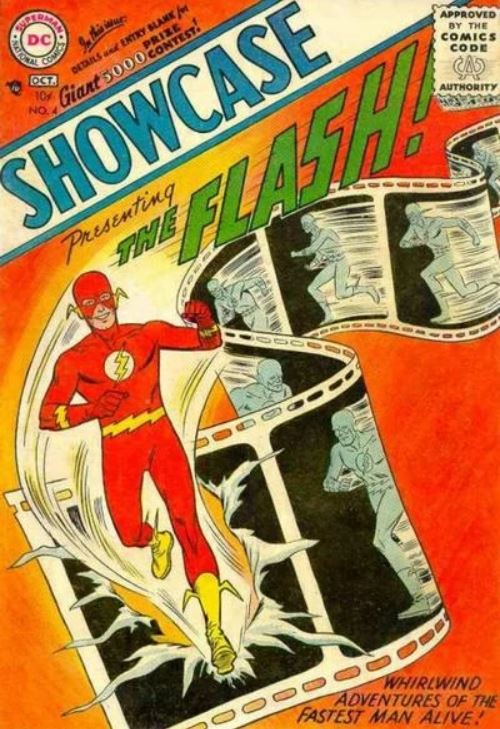
During the Silver Comic Book Age, which lasted until the early 1970s, some of the most famous comic book artists and writers appeared on the scene, including Stan Lee and Jack Kirby. This legendary duo is best known for creating arguably the most popular superhero of all times — Spider-Man. Spidey’s character debuted in Amazing Fantasy #15, in August of 1962.
Many comic book historians consider the Silver Age of Comic Books the most important of them all. During this era, superheroes were mainly portrayed as emotional, with flaws like any other human being. This helped make them more relatable and popular among readers.
This change in the depiction of superheroes marked the end of the Silver Age era.
Bronze Age Of Comics
The Bronze Age of Comic Books began in 1973 with the release of The Amazing Spider-Man #122. In this comic book, writer Gerry Conway and artist Gil Kane depict the deaths of Spider-Man’s great love, Gwen Stacy, and his archnemesis — The Green Goblin.
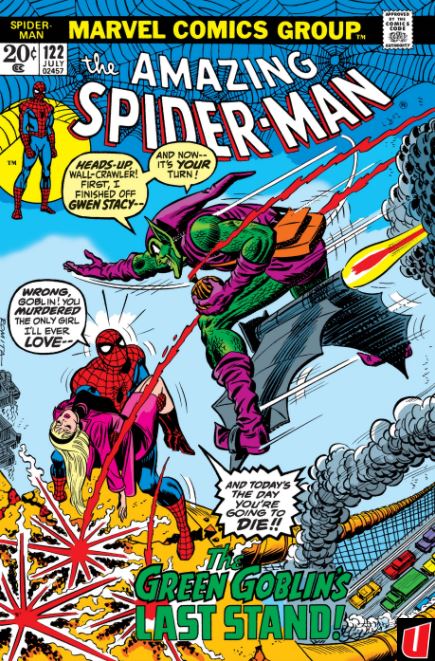
Before Spiderman #122 was released, characters’ deaths weren’t often featured in comics. But from that moment on, darker storylines became more common. Writers went back to creating stories about scary, real-life problems, the way they did before the launch of the CCA.
Death, alcoholism, drug use, and environmental pollution became hot topics in the Bronze Comic Book Age. Comic book creators explored the failings of humankind more than ever before.
For example, in the Demon In A Bottle series, they described Iron Man’s, i.e. Tony Stark’s, battle with alcoholism and the way he confronted his “demon.”
Artists and writers were inspired by pulp fiction, Westerns and horror stories, which translated into their work. Characters such as Conan the Barbarian, Warlord, Beowulf, John Carter, and Swamp-Thing all debuted during the Bronze Age. These heroes became staples not only of the comic book culture but also of the 1970s and early 1980s pop culture.
Contemporary social issues were described in many comics created during this comic book age. The most notable title is possibly the story called I Am Curious: Black, which describes how Lois Lane, Superman’s girlfriend, becomes a black woman for a day.
While many historians argue that the Bronze Age of Comics never really ended, most cite 1986-87 as the final stages of the era. This timeline synchs up with the release of what most critics agree is the greatest graphic novel ever written and the exemplar of the Modern Age of Comic Books — Alan Moore’s Watchmen.

Modern Age Of Comics
The Modern Age of Comic Books is by far the most diverse and popular era in comic book history. It started around 1987, and it’s still going strong.
Today, comic book characters seem to be more popular than ever before. This is largely due to hugely successful movies and TV shows based on comic books, such as Spider-Man: No Way Home, Avengers: Endgame, Agents of S.H.I.E.L.D, and many others.
The Modern Age Of Comics is often called the Dark Age Of Comics because of its emphasis on gritty and realistic storylines, as seen in The Dark Knight Returns, Watchmen, Crisis on Infinite Earths, The Civil War, and The Infinity Gauntlet.
The early years of the Modern Age also brought significant changes to some long-standing comic franchises.
For instance, the Infinity Gauntlet comic book series went through some major changes — the reboot version introduced readers to new character storylines. Most protagonists also had new personalities and looks, and authors killed off several high-profile characters such as Supergirl and The Flash.
Comic book publishers release reboots of some of their most popular stories every few years, leading to huge sale spikes among new audiences.
The Modern Age also changed the way comics were distributed. Digital comic books, such as BIOWARS, became a huge hit. Graphic novels also gained popularity, including the contemporary staples Blankets and Jimmy Corrigan: The Smartest Kid on Earth.
The most important change that’s happened during the Modern Comic Book Age is the success of independent comic book publishers, like Image. They’ve found mainstream success with The Walking Dead, Invincible, and Manifest Destiny, which are viewed as contemporary classics.
Even though Marvel and DC Comics continue to dominate the market, readers can now benefit from a more diverse comic publishing landscape and explore the creative works of other publishers.
Takeaways On Comic Book Ages — What Does The Future Hold For Comics?
From Golden and Silver to Bronze and Modern Ages, comic books have always reflected the state of our society and culture. They also represent means of escapism for many and a safe space where readers can “hide” when the real world becomes too much.
But what does the future hold for the world of comics?
In terms of format and content, graphic novels are already all the rage, as are children’s comics, which have surpassed superhero comics as the most popular genre.
As for comic book themes, the Covid-19 pandemic will likely be explored in some future storylines. But as always, readers will continue to turn to comics for solace and consolation. Comic books and graphic novels will surely provide a light at the end of a very bleak tunnel.
It is also safe to assume that digital comics will reign over print in the years to come, because they are more accessible and sustainable.
Comic Book Ages FAQs
The Golden Age of comics, from 1938 to 1956, introduced legendary superheroes like Superman, Batman and Wonder Woman. This era shaped the superhero genre and made comics a big part of American pop culture.
Created in 1954, the Comics Code Authority set strict rules for comic content, censoring horror and crime stories. This pushed comics toward family-friendly superhero tales in the Silver Age.
Digital technologies have transformed the Modern Age of comics, making them easier to create, share, and read worldwide. This has also opened the door to new and creative ways of storytelling.
In the 1970s, big societal changes like the civil rights movement and anti-war protests inspired comics to get more real. Bronze Age stories started tackling tough topics like racism, drug abuse and political corruption, showing that comics could reflect the challenges of the real world.
The Modern Age of comics stands out for its diverse stories, complex characters and the rise of independent publishers. During this time, graphic novels became a respected form of storytelling and digital technology made creating and sharing comics easier than ever.





